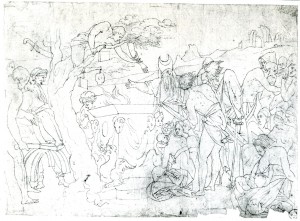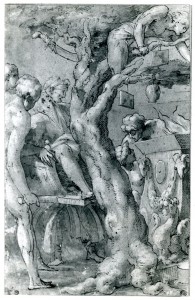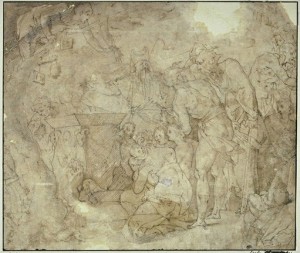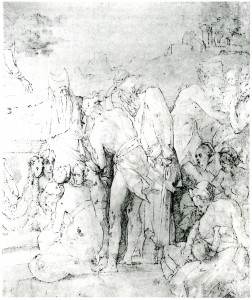For the Fresco in the Gallery of Francis I, Fontainebleau
c. 1531/1532-1534
|
D.50A. Göttingen, Kunstsammlung der Georg-August Universität, unnumbered.1 Pen and ink over black chalk, 30.8 x 43.1. Several small pieces are missing at the bottom, especially at the right. Inscribed in ink at the lower left: Droest. LITERATURE: Carroll, 1987, 276, and n. 2, under no. 87. Brugerolles and Guillet, 1994, 198, n. 16, mentioned in relation to the drawing in the Ensba. |
|
D.50B. Paris, Ensba, Masson 1196 (formerly Masson 314). Pen and ink and brown wash, heightened with white, on light brown paper, 26.7 x 16.9. PROVENANCE: Jean Masson (Lugt 1494a). LITERATURE: Masson, 1927, 50, no. 314, as Rosso. Kusenberg, 1931, 151, no. 51, 149, under no. 12, as a copy of Boyvin’s engraving (see below) and by the same hand as Louvre inv. no. 1574. Carroll, 1964 (1976), I, Bk. I, 250, II, Bk. II, 381-386, D.42A, Bk. III, Fig. 110. Carroll, 1966, 175, n. 34, as a partial copy of a lost drawing by Rosso for the early version of the Scene of Sacrifice in the Gallery of Francis I. Béguin and Pressouyre, 1972, 138-139, mention it as a copy of a lost drawing (and confused with Masson 898). Carroll, 1987, 276, and n. 2, under no. 87. Brugerolles and Guillet, 1994, 196, Fig., 198, n. 16, as a fragment of a copy of a drawing by Rosso. Béguin, 1995, 194, as possibly matching the fragment in a French private collection. |
|
D.50C. Paris, Louvre, Inv. 1574. Pen and ink and some wash over black chalk, 25.1 x 29.3; laid down; wm?. There is a tear through the upper left corner, a piece is missing at the upper right and the upper right corner is torn away, the lower right corner is cut away, filled and re-drawn, and there are several holes in the drawing. Faintly inscribed in pencil at the lower right: Rous? PROVENANCE: Saint-Morys. LITERATURE: Kusenberg, 1931, 149, no. 12, 151, under no. 51, as a copy of Boyvin’s print (see below), and by the same hand as Paris, Ensba, Masson 1196. Barocchi, 1950, 126, Fig. 79, as a copy of the fresco in the gallery before it was completely repainted. Longhi, 1951, 59 (1976, 99), as Rosso. Panofsky, 1958, 166, n. 16, as reproducing Rosso’s first version of the Sacrifice and as possibly by Boyvin. Carroll, 1964 (1976), I, Bk. I, 250, II, Bk. II, 381-386, D.42B, Bk. III, Fig. 111. Carroll, 1966, 175, as a partial copy of a lost drawing by Rosso for his first version of the Sacrifice. Béguin and Pressouyre, 1972, 138-139, as a variant of Rosso’s Sacrifice in the gallery. Carroll, 1987, 276, and n. 2, under no. 87. Saint-Morys, 1987, II, inv. no. 1574, giving his attribution to Rosso as well as Morel d’Arleaux’s (509). Scailliérez, 1992, 132, no. 57C, 133, Fig.C, as a studio copy of a lost drawing although it has also been thought an original drawing. Béguin, 1992 (1987), 89, 90, as close to the drawing in a French private collection. Brugerolles and Guillet, 1994, 198, n. 16, mentioned in relation to the drawing in the Ensba. |
|
D.50D. France, Private Collection. Pen and ink and wash heightened with white, measurements unknown. LITERATURE: Béguin and Pressouyre, 1972, 138, as Rosso (?). Béguin, 1992 (1987), 89, 90, 92, Fig. 3, as Rosso?, and closely related to the drawing in the Louvre. Béguin, 1995, 194, as showing the other half of the first version of the Sacrifice, and which might match the fragment in the Ensba. |
A careful comparison of the details of these four drawings indicates that all four were derived from a single lost drawing by Rosso, although it is possible that another complete and accurate lost copy served as the model for some or all of these copies. The drawing in the Ensba is the most finished and most carefully executed of the copies. Its media, technique, and handling show a kind of draughtsmanship that must go back to an original drawing very similar to Rosso’s Annunciation of around 1531 or 1532 in the Albertina (Fig.D.43a) and his Petrarch drawing of around 1534 at Christ Church (Fig.D.47a). Only the use of parallel lines and cross-hatching in pen and ink in the Ensba drawing differentiate it from the Albertina and Christ Church drawings. This shading, which also appears in the Louvre copy and the copy in a private collection, creates another level of shadow that deepens the tone of the washes; it was certainly a part of the lost original drawing as it appears in three of the copies. The penmanship of this shading can to some extent be compared to that in Rosso’s study (Fig.D.26A) for the figure of Christ in the Borgo Sansepolcro Pietà. In the Göttingen drawing, it is basically the outlines of the figures and objects that are copied, but these follow those that are found in the other copies. However, the Göttingen copy is the only one that records the entire scene; a line along its right edge marks the limit of the composition at this side, while two short vertical lines at the far left seem to mark its limit there. The Ensba drawing shows the left third of it; the Louvre copy, the center two-thirds; the copy in a private collection, the right two-thirds.
Rosso’s lost drawing was a very complete study for the first version of his Scene of Sacrifice planned for the Gallery of Francis I and designed during the earliest phase of his work on the project. This phase probably began c. 1531 or c. 1532 and lasted most likely until the stucco workers initiated their activity in the gallery in 1534, it would seem (see P.22). The schematization of the architecture of the altar – see especially the merely blocked-out cornice – is found in other drawings by Rosso; it is most clearly seen in the copies of his Allegory of the Virgin as the Ark of the Covenant of 1529.
The Louvre and Ensba copies do not at all appear to be by the same hand, as Kusenberg thought, and there is no reason to believe, as the Panofskys conjectured, that the Louvre drawing is by Boyvin. The Louvre copy and the copy in a private collection are very similar and may be derived from another copy without the full washes shown in the copy in the Ensba.




